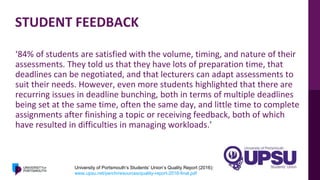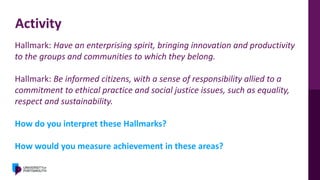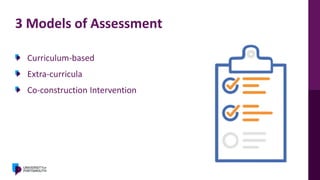A co-constructed curriculum:
- 1. A co-constructed curriculum: a model for implementing total institutional change in partnership with students Dr Harriet Dunbar-Morris PFHEA, Dean of Learning and Teaching Amy Barlow, Head of Academic Development Angel Layer, student and former Vice-President University of Portsmouth Students’ Union SEDA Spring Teaching, Learning and Assessment Conference 2019: Collaboration to support the student experience and progression
- 2. Our Co-construction Story begins with student consultation in order to create our Education Strategy 2015-2020 2014 Co-created University and Education Strategy 2015 Co-created Hallmarks Launched Education Strategy 2016-2020 2019/20 Teaching of Curriculum 2019 courses 2017/18 Launch of Curriculum 2019 project
- 3. Education Strategy We will: • Empower students as partners in a community of learning where staff, students, practising professionals and employers can work together to learn, create, research and solve problems • Promote, develop and foster a culture of co-creation and partnership, and extend the opportunities for students to engage in peer and inter-cohort training and mentoring programmes • Encourage feedback from our students and act upon it • Engage with our students, including through working in partnership with the Students’ Union, to ensure that their voice is heard in discussions and decisions that impact on their education or the wider student experience
- 4. The National Union of Students (NUS) understands partnerships as “…investing students with the power to co-create, not just knowledge or learning, but the higher education institution itself…a corollary of a partnership approach is the genuine, meaningful dispersal of power….shared responsibility for identifying the problem or opportunity for development, for devising – importantly – for co-delivery of that solution”. (NUS 2012, p.8). NUS (2012) A manifesto for partnership [Internet]. London: National Union of Students. Available from: https://www.nusconnect.org.uk/resources/a- manifesto-for-partnership [Accessed10 July 2018].
- 5. Students as active collaborators ‘There is a subtle, but extremely important, difference between an institution that ‘listens’ to students and responds accordingly, and an institution that gives students the opportunity to explore areas that they believe to be significant, to recommend solutions and to bring about the required changes. The concept of ‘listening to the student voice’ – implicitly if not deliberately – supports the perspective of student as ‘consumer’, whereas ‘students as change agents’ explicitly supports a view of the student as ‘active collaborator’ and ‘co-producer’, with the potential for transformation.’ Dunne, E. and Zandstra, R. (2011) Students as change agents – new ways of engaging with learning and teaching in higher education. Bristol: A joint University of Exeter/ESCalate/Higher Education Academy Publication. http://escalate.ac.uk/downloads/8244.pdf (Accessed 10 July 2018).
- 6. Listening and responding to the student voice Gathering information Triangulation of information Acting on information
- 7. Listening and responding to the student voice Assessment and Feedback
- 8. Portsmouth graduates will be knowledgeable, informed, intellectually curious, responsible, self- aware and self-motivated, independent learners set for success in their future careers Portsmouth Graduate EVELOPING THED
- 9. Discussion What do students expect to gain from their degrees, in the current climate of Higher Education? What do they expect from the individuals who are teaching them?
- 10. STUDENT FEEDBACK
- 11. STUDENT FEEDBACK ‘Some units I feel have a perfect workload i.e. ones which include two 2000 essays/reports which are due in at the end of first term and end of second term. However there are other units which have two hours worth of lectures per week plus two hour practical which have assignments due every 3/4 weeks.’ ‘Not having all the assessments due in on the same date.’ ‘All artefacts due in the same time.’ ‘I like when the units have a clear assessment guidance.’ ‘I think have summative examinations at the end of the academic year in May-June work well. Could possibly introduce a more formative exam period in January.’
- 12. STUDENT FEEDBACK ‘84% of students are satisfied with the volume, timing, and nature of their assessments. They told us that they have lots of preparation time, that deadlines can be negotiated, and that lecturers can adapt assessments to suit their needs. However, even more students highlighted that there are recurring issues in deadline bunching, both in terms of multiple deadlines being set at the same time, often the same day, and little time to complete assignments after finishing a topic or receiving feedback, both of which have resulted in difficulties in managing workloads.’ University of Portsmouth’s Students’ Union’s Quality Report (2016): www.upsu.net/perch/resources/quality-report-2016-final.pdf
- 13. CURRICULUM 2019 Revised credit structures across our course portfolio All courses mapped to deliver the Hallmarks of Portsmouth Graduate Co-construction of new modules TESTA targeted to improve low NSS Assessment and Feedback Scores Student Union representation across steering and project groups
- 14. Hallmarks in Curriculum Design Ensuring an excellent student experience through the delivery of courses that provide the knowledge, skills and attributes for success, as defined in the Hallmarks of the Portsmouth Graduate. e.g.: Be able to synthesise new and existing knowledge to generate ideas and develop creative solutions of benefit to the economy and society. Be intellectually curious, embrace challenges and seize opportunities for development.
- 15. Activity Hallmark: Have an enterprising spirit, bringing innovation and productivity to the groups and communities to which they belong. Hallmark: Be informed citizens, with a sense of responsibility allied to a commitment to ethical practice and social justice issues, such as equality, respect and sustainability. How do you interpret these Hallmarks? How would you measure achievement in these areas?
- 16. A Reflective Tool for Course Teams Hallmark: Be able to synthesise new and existing knowledge to generate ideas and develop creative solutions of benefit to the economy and society Prompts: How does the course enable students to develop creative solutions to likely problems/scenarios? How does the course provide an environment that encourages students to generate new ideas and solutions to employment related issues/challenges/problems? How do students demonstrate their ability to develop creative solutions to benefit society? How are inclusive learning outcomes, practices, skills and/or attributes appropriate for diverse societies, cultures and individuals being developed?
- 17. A Reflective tool for Students
- 18. ‘Assessing Graduate Attributes is essential to their successful implementation’ How can we measure behaving ethically? How can a contribution to society be quantified? What does curiosity and seizing opportunities look like in a Course Specification? Barrie, S. C. (2007). A conceptual framework for the teaching and learning of generic graduate attributes. Studies in Higher Education, 32(4), 439-458. http://dx.doi.org/10.1080/03075070701476100
- 19. Learning Outcomes? Ipperciel, D., & ElAtia, S. (2014). Assessing graduate attributes: Building a criteria-based competency model. International Journal of Higher Education, 3(3), 27. Attributes Sub-attributes Interpretation Ethical responsibility Can adopt the perspective of moral principles rather than self-interest Global citizenship Can consider issues from a global perspective Community engagement Can consider issues from the perspective of their impact on the community Social and environmental awareness Can adopt the perspective of the public good and take into consideration our embeddedness within society and nature Professionalism Is willing to meet the level of expertise and deontological expectations of her intended profession
- 20. 3 Models of Assessment Curriculum-based Extra-curricula Co-construction Intervention
- 21. Assessing the Hallmarks in the curriculum Disciplinary application Digital mapping of progression from level 4-6 via Portfolio tool Compulsory engagement via integrated Pass/Fail module Embedded into Personal Tutoring conversations Cyclical feedback on progression
- 23. Extra-Curricula Mapped to Active Change Leader Award Recognition for student engagement activities Student Mentors, Ambassadors, DigiChamps Pre-accredited projects that map against Hallmarks
- 24. Co-construction Intervention from 3rd party ‘Learning Agreement’ Workshop by Student Union and Academic Development Team (away from teaching spaces, with refreshments) creates action plan for teaching team and students Lecturers and Students co-construct course opportunities and codes of behaviour which will enable them to progress against selected Hallmarks. This includes identifying new opportunities within modules that have flexible assessments and potential project ideas Outcomes - increased attendance and engagement, focus of community work for the course, new opportunities to work with industry, peer mentoring, visible artwork in teaching spaces to reflect Hallmark conversations
- 25. Discussion We have presented the model for implementing the new curriculum and the tools provided to facilitate the curriculum design process. What similarities do you see with your own institutional context?
- 26. Lessons learnt Shared language and terminology vs. shared interpretations Different disciplinary interpretations Ongoing communication channels




![The National Union of Students (NUS) understands
partnerships as “…investing students with the power to
co-create, not just knowledge or learning, but the higher
education institution itself…a corollary of a partnership
approach is the genuine, meaningful dispersal of
power….shared responsibility for identifying the problem
or opportunity for development, for devising –
importantly – for co-delivery of that solution”. (NUS
2012, p.8).
NUS (2012) A manifesto for partnership [Internet]. London: National Union
of Students. Available from: https://www.nusconnect.org.uk/resources/a-
manifesto-for-partnership [Accessed10 July 2018].](https://image.slidesharecdn.com/uopupsusedaconferenceapril2019v3-190516142259/85/A-co-constructed-curriculum-4-320.jpg)

























